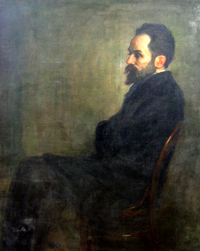Eligiusz Niewiadomski

Eligiusz Niewiadomski (Warsaw, December 1, 1869 – January 31, 1923, Warsaw) was a Polish modernist painter and art critic who belonged to the right-wing National Democratic Party till 1904[1] and later continued supporting it. In 1922 he assassinated Poland's first President, Gabriel Narutowicz.
Life
Niewiadomski was born into a family of gentry descent. His father, Wincenty Niewiadomski, of the Prus coat-of-arms, was a veteran of the January Uprising and a worker at the Warsaw mint. At the age of two, Eligiusz lost his mother Julia, and was raised by his elder sister Cecylia. After graduating from a local trade school in 1888, Niewiadomski moved to St. Petersburg, where he continued his studies at the Imperial Academy of Arts. He graduated in 1894 with honors, and won a scholarship to the École Supérieure des Beaux-Arts in Paris. After his return to Warsaw, he became a student of Wojciech Gerson, one of the best-known Polish artists of the age.

After 1897, he taught drawing at the Warsaw Polytechnic. He also collaborated with a number of Warsaw-based magazines and newspapers as a journalist and art critic, which gave him considerable notoriety, mostly among the artists themselves. He became involved in various artistic movements, among them the "re-discovery" of the Tatra Mountains, which at the time attracted some of the most renowned Polish painters, poets and writers as a source of inspiration. Niewiadomski prepared and published a map of the Tatras, one of the first tourist maps of the area. He also prepared a set of historical maps of Poland, Album of the History of Poland (1899). He also became involved in the reorganization of the Zachęta art society. Using contacts acquired there, he promoted the idea of creating a separate Academy of Fine Arts in Warsaw. However, when the school was finally opened in 1903, Niewiadomski was not invited to teach there.
Politically, Niewiadomski was a strong supporter of nationalism, particularly the National League. In 1901 he was arrested by the Tsarist police for smuggling nationalist propaganda booklets from Galicia into Vistula Land. Though released after several months in the Pawiak Prison, he lost his job at the Warsaw Polytechnic and fell into an impoverished state. This further radicalized his political beliefs. During the Russo-Japanese War he promoted the idea of perpetrating anti-Russian sabotage, for which he was excluded from the National League.
To make a living, Niewiadomski began teaching art classes at numerous schools and churches in Poland. He also made frescoes in Konin's St. Bartholomew's Church. However, his two-volume monograph On Mediaeval Art sold poorly, and Niewiadomski was on the verge of being forgotten by his contemporaries.
After the outbreak of World War I he remained in Warsaw, where he published brochures and manifestos describing his views on the role of art. He also continued teaching art history and artistic technique at various schools. On March 1, 1918, he was appointed director of painting and sculpture at the Regency Council's Ministry of Culture, a post that had previously been turned down by numerous artists.
After Poland regained independence, Niewiadomski joined the newly-reborn country's Ministry of Culture. In 1920, during the Polish-Soviet War, he tried to join the Polish Army but was turned down as too old. However, he was accepted by Polish intelligence and served as a translator of Russian documents. During the last months of the war, he finally managed to convince his superiors to transfer him to front-line service and fought in the 5th Legions Infantry Regiment.
Demobilized in 1921, Niewiadomski returned to the Ministry of Culture and continued his work there as a clerk. However, on November 8, 1921, after Antoni Ponikowski's government refused to grant Niewiadomski's department a higher budget, he resigned his post. He then devoted himself to writing and prepared several monographs on 19th- and 20th-century Polish painting, and on the theory of art. He made his living illustrating books.
Assassin

On December 9, 1922, Gabriel Narutowicz was elected by the National Assembly as the first President of Poland. After a heated debate, Narutowicz's candidacy managed to gather 289 votes, including 113 votes of various national minority MPs. The defeated candidate of the National Democratic Party Maurycy Zamoyski gathered 227 votes, yet the National Democrats decided to boycott the President and announced that he was elected by the Reds, Jews and Germans rather than Poles. This started a period of civil unrest in Warsaw, where the supporters of nationalist ideas protested against the election of their president.
On December 16, 1922, the newly elected President attended the opening of an art exhibition at the Zachęta Art Gallery. Niewiadomski, a frequent guest at such gatherings, approached Narutowicz and shot him. Arrested on December 30, he was sentenced to death by firing squad, and the sentence was carried out at the Warsaw Citadel on January 31, 1923. He was 53 years old. His body was interred at Warsaw's Powązki Cemetery.
After his execution, Niewiadomski remained a controversial figure. His funeral was attended by 10,000 people.[2] He was depicted by some right-wing journalists as a hero, but most Poles perceived him only as a murderer.[2]
See also
- List of Poles
Notes
- ↑ Wapiński 1980, 221.
- ↑ 2.0 2.1 (Polish) Bartłomiej Kozłowski, "Proces o zabójstwo prezydenta Narutowicza", Polska.pl: Kalendarium, Wydarzenia; 2003
References
- Wapiński, Roman (1980). Narodowa Demokracja 1893-1939. Wrocław: Zakład Narodowy Imienia Ossolińskich. ISBN 83-04-00008-3.
|